This post may contain affiliate links. For more information, please see our affiliate policy.
Learn the secrets to making Chipotle Cilantro Lime Rice in the comfort of your own kitchen. This copycat recipe starts with getting the right type of rice and cooking it in a non-traditional way. This rice is soft and fluffy with just the right amount of chew and no stickiness.
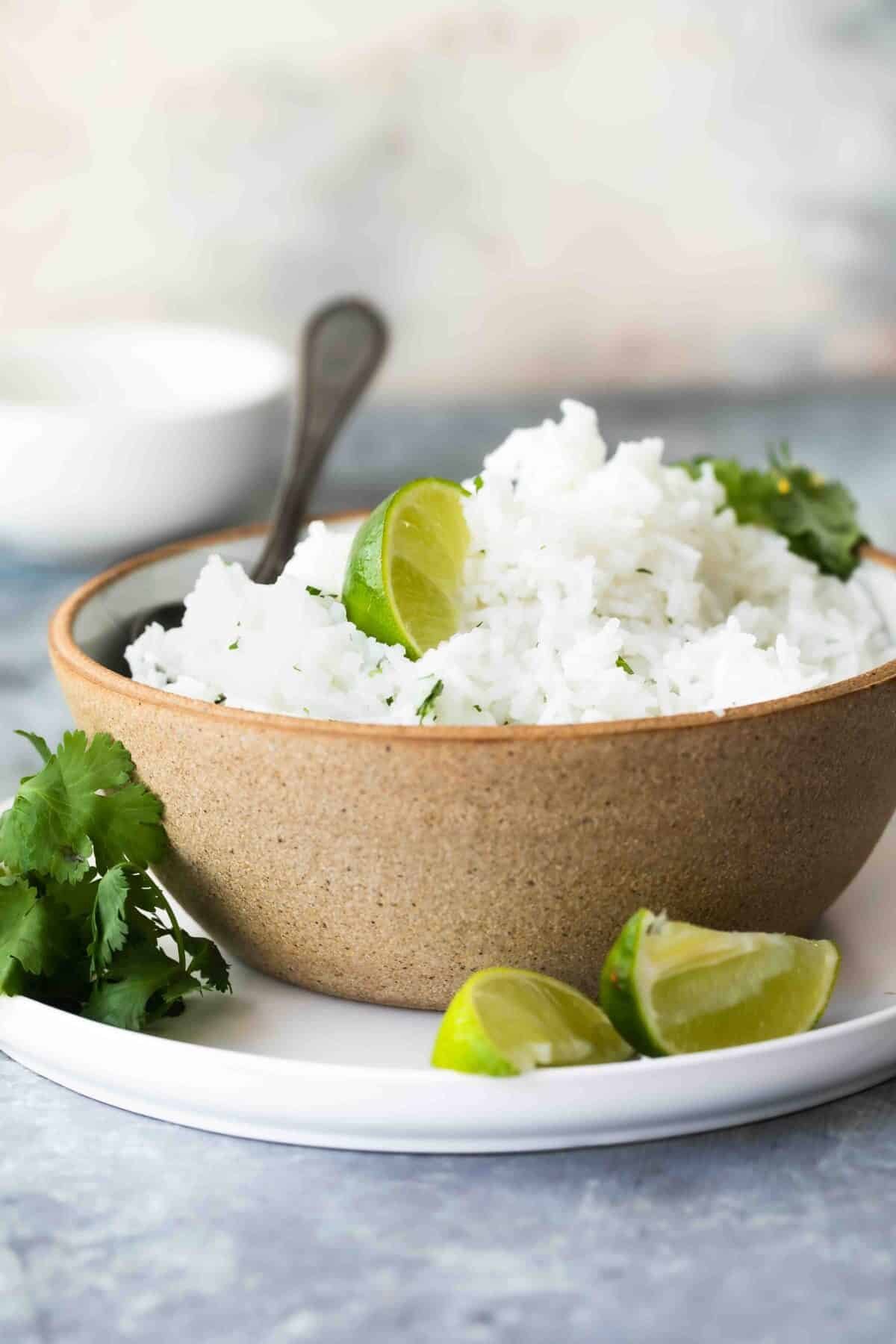
I’ve taken a deep dive into cooking perfect, fluffy rice on the stove or using a rice cooker. By using Basmati rice, and cooking it in lots of water (aka “the pasta method”), I was able to closely mimic their recipe.
You don’t have to use Basmati, though; I experimented with other kinds of rice and cooking methods and have outlined those as well.
Table of Contents
Recipe ingredients
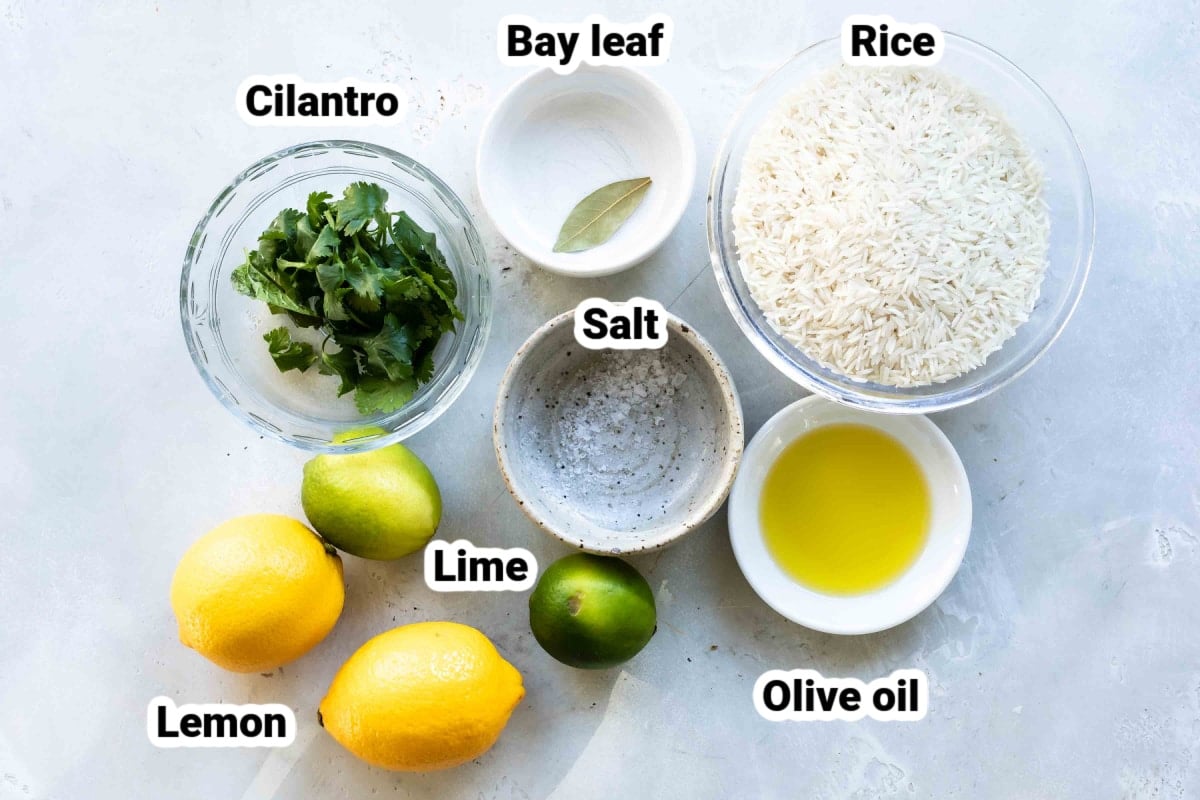
At a Glance: Here is a quick snapshot of what ingredients are in this recipe.
Please see the recipe card below for specific quantities.
Ingredient notes
“Grain” refers to the rice’s length to width ratio, when cooked. More than likely, you’d be able to tell whether a rice is short-grain or long-grain just by looking at it. Medium is a tad more difficult, because sometimes it gets lumped (clumped?) into the short-grain category.
- Short grain rice is a plump, stubby grain. This rice is most commonly used for making sushi. Short-grain rice has more starch, so it clumps together easily.
- Long grain rice is slender and long, as its name suggests. Varieties include American white and brown rices, Jasmine rice, and Basmati rice. Long-grain rice has a firm, dry texture, and is best for side dishes, pilafs, and salads.
- Medium grain rice is somewhere in between. It produces moist, tender, slightly chewy grains that stick to each other when cooked. Common medium-grain rices include Arborio and Valencia, which are used to make risotto, and Bomba rice, which is used in paella.
One thing I’ve definitely learned along the way is to use the type of rice listed in a given recipe. Each one has different characteristics, so if you swap in a kind that hasn’t been tested, you might not get the result you are hoping for.
Step-by-step instructions
Method 1: How to Make Perfect Basmati Rice on the Stove (pasta method)
Even though I had cooked Basmati rice before, I had always cooked it using the typical method we’ve all been taught: measure a specific ratio of rice to water, bring to a boil, cover, and cook until all the water has absorbed. Then I learned about a new (well, new to me) method for cooking Basmati rice, and it changed my rice-cooking life.
If you’ve always thought cooking rice was too tricky, this method is for you. It’s called the pasta method; if you can cook pasta, you can definitely make perfect rice.
- Bring 8 cups water to a boil in a large pot. Add rice, bay leaf, oil if using, and salt to taste (I like 2 teaspoons). Stir and return to a boil.
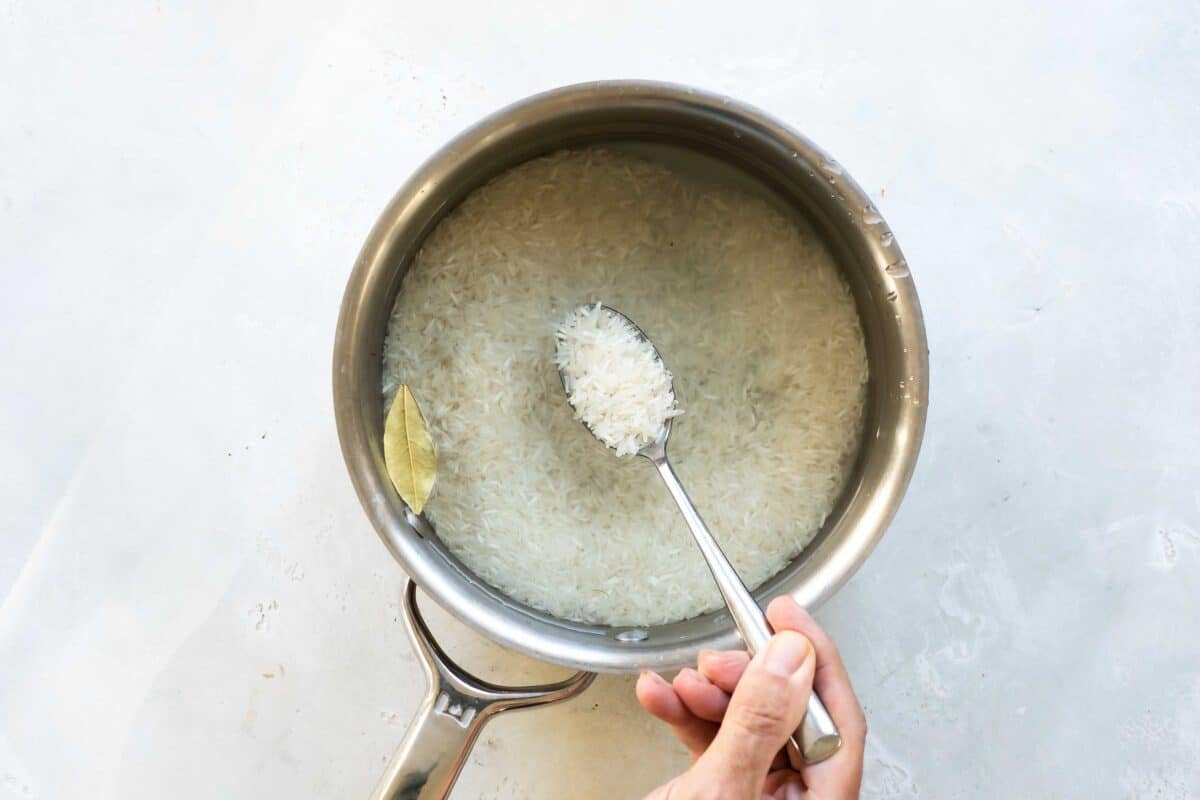
- Boil uncovered for 10 to 12 minutes (for me it’s always 12, but some readers have reported mushy rice after 12 minutes, so keep an eye on yours).
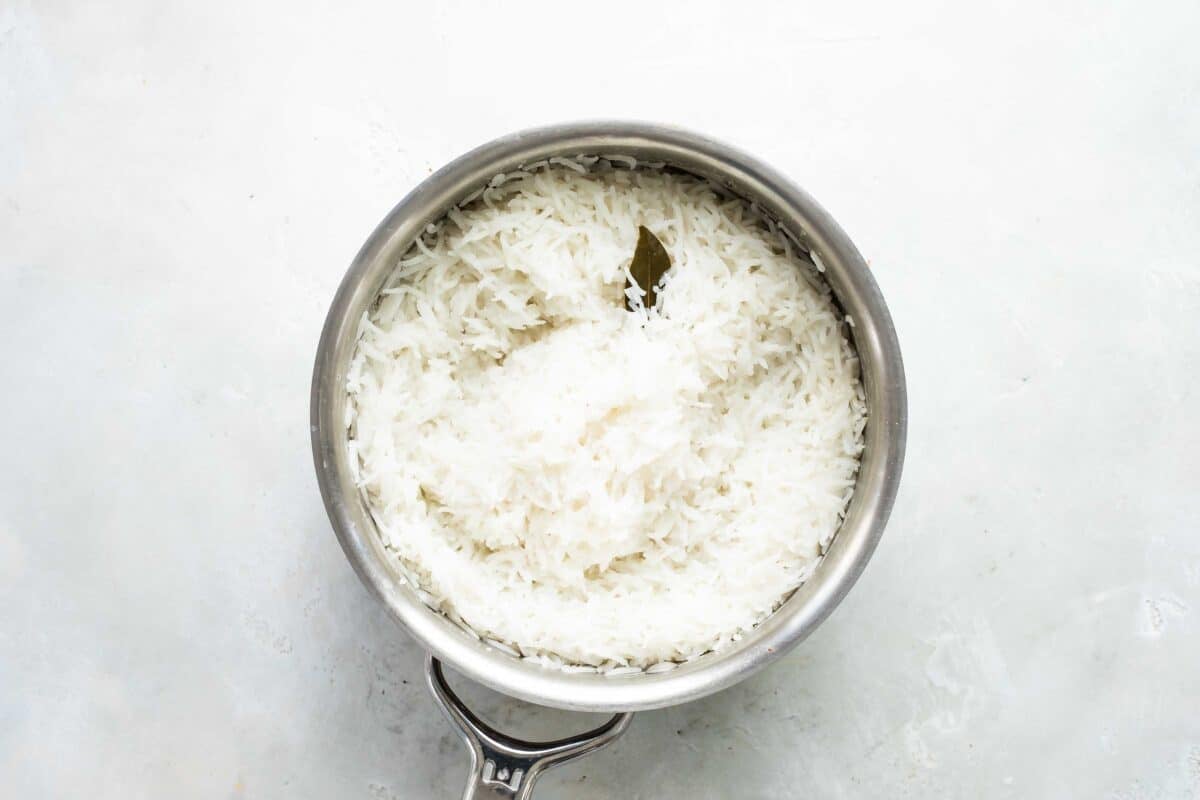
- Remove bay leaf. Using a fine mesh strainer, drain rice and rinse with hot water.
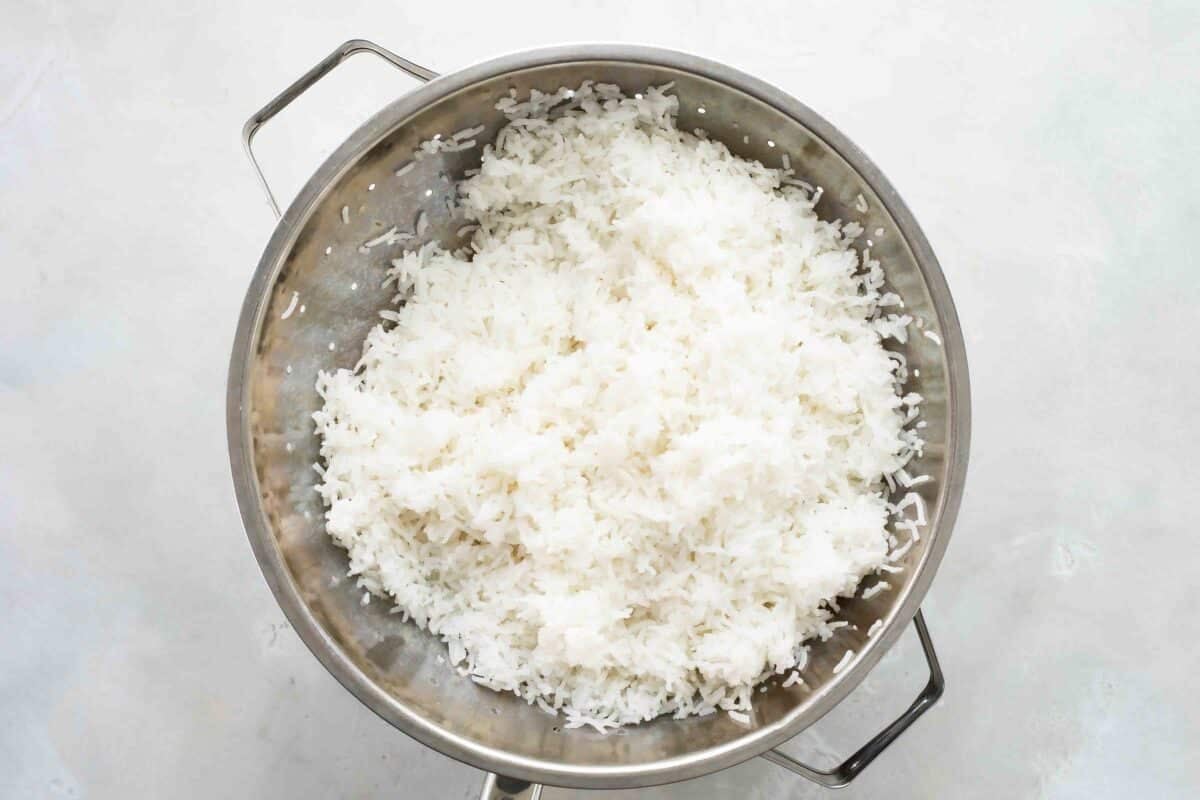
- Stir in cilantro, lime juice, and lemon juice. Season to taste with salt (I like an additional ¼ teaspoon). Serve hot or at room temperature.
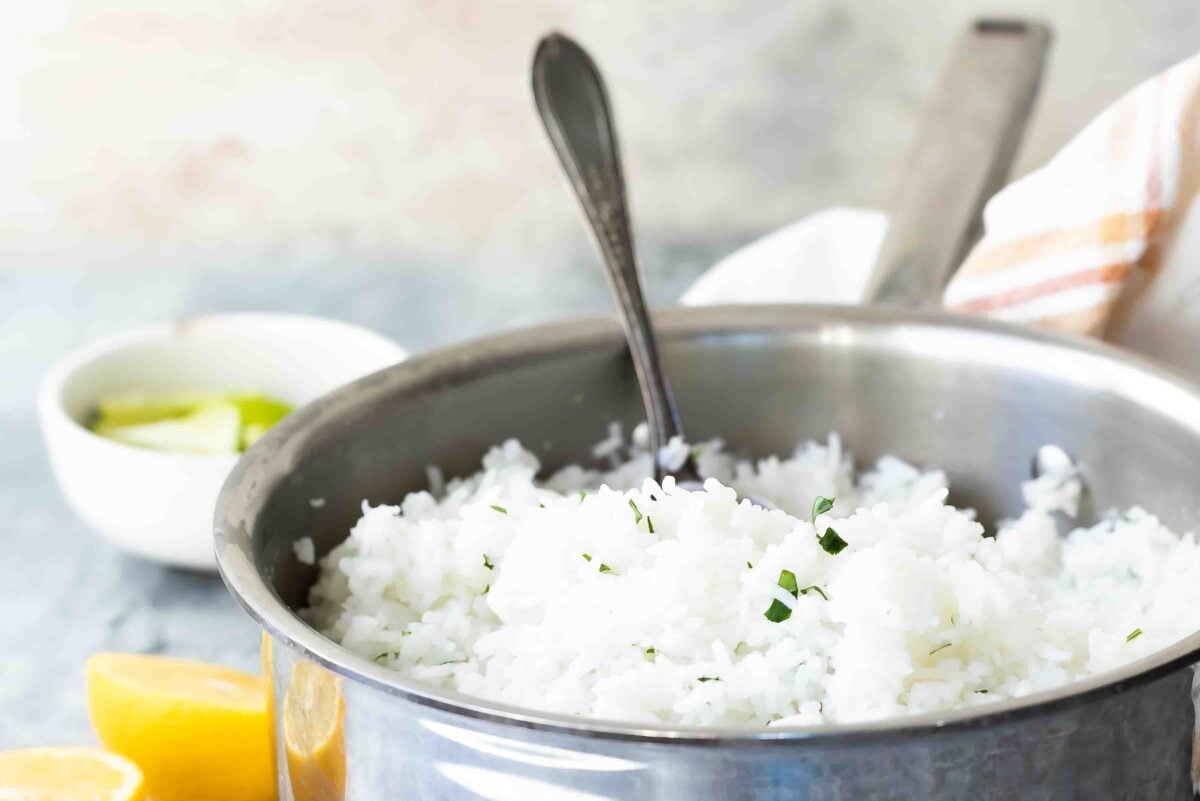
Method 2: How to Make Long-Grain Rice on the Stove (absorption method)
If you don’t have Basmati rice, you can still use another type of long-grain rice and still have a great version of Cilantro Lime Rice. I recommend rinsing it before cooking it to remove excess starch.
To rinse the rice, place it in a fine-mesh sieve under cool water and rinse until the water runs clear. Drain well before adding the rice to the pot or rice cooker. Or, soak the rice in a large bowl of water for up to 30 minutes to help remove starch while conserving water.
- Bring 4 cups water to a boil in a large pot. Add rice, bay leaf, oil if using, and salt to taste (I like 2 teaspoons). Stir and return to a boil.

- Reduce heat to low, cover, and cook for 15 minutes.

- Remove bay leaf. Stir in cilantro, lime juice, and lemon juice. Season to taste with salt (I like an additional ¼ teaspoon). Serve hot or at room temperature.
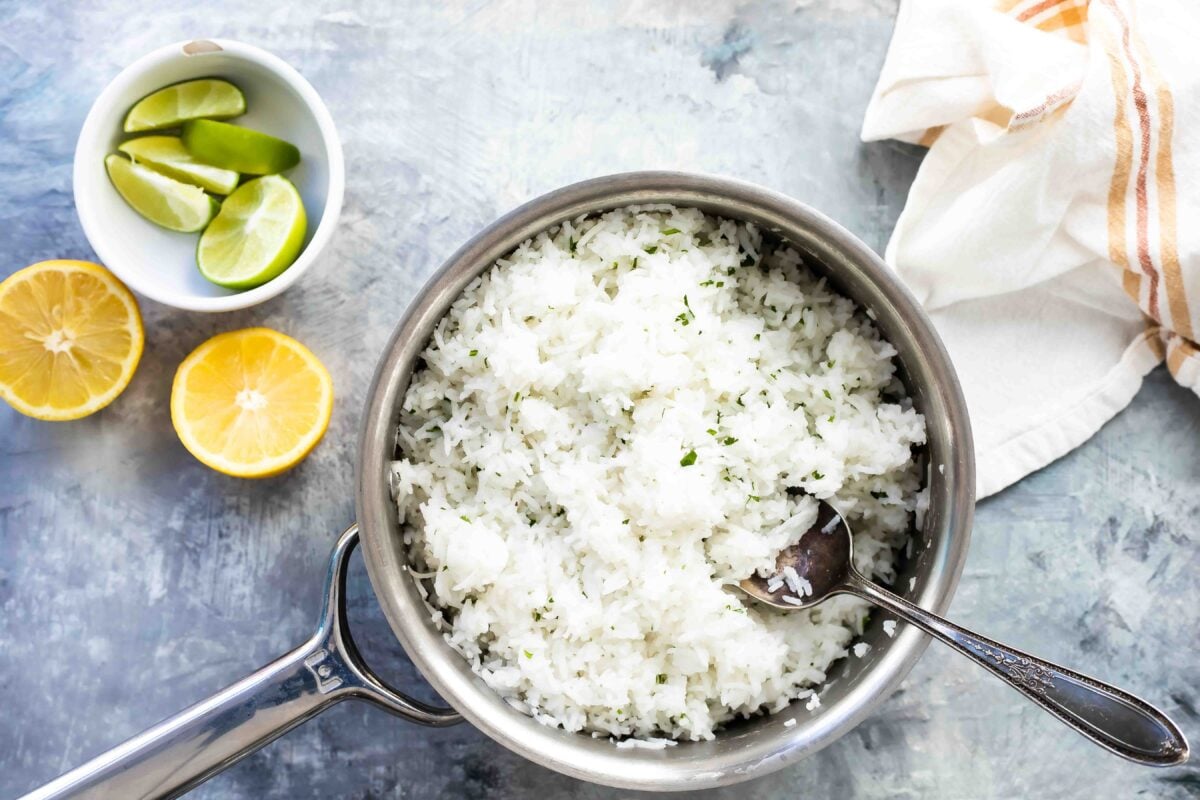
Method 3: How to make rice in a Rice Cooker
I love using a rice cooker! It’s completely hands-free and all I have to do is push a button. I use and recommend the Aroma Housewares Rice Cooker, which you can get on Amazon for $30. Rice cookers usually come with a measuring cup that’s a little smaller than a standard cup. You simply count out the number of cups you’re making, then fill the cooker with water up to the level on the side that matches the number of cups you’re making.
- Add rinsed rice, water (according to manufacturer’s instructions, bay leaf, salt (I like 1 teaspoon), and oil if using. Close rice cooker, plug in, and turn on.
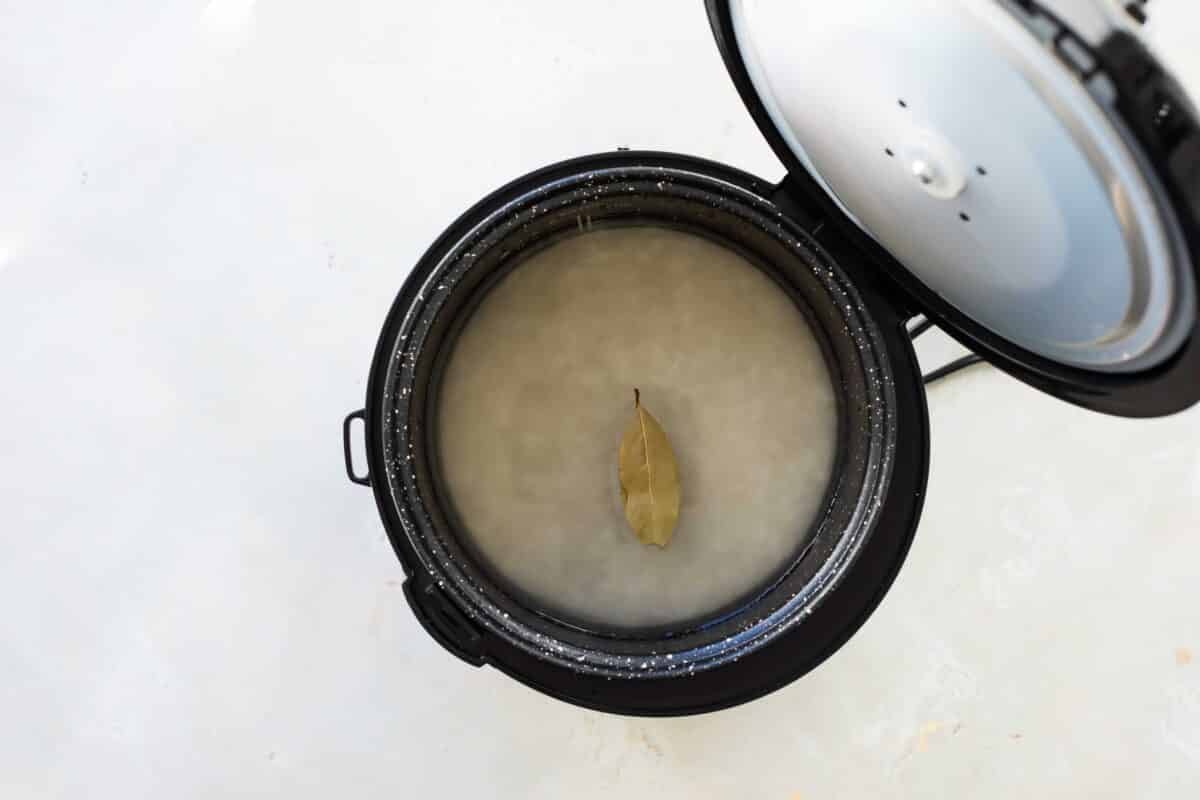
- Cook according to manufacturer’s instructions.
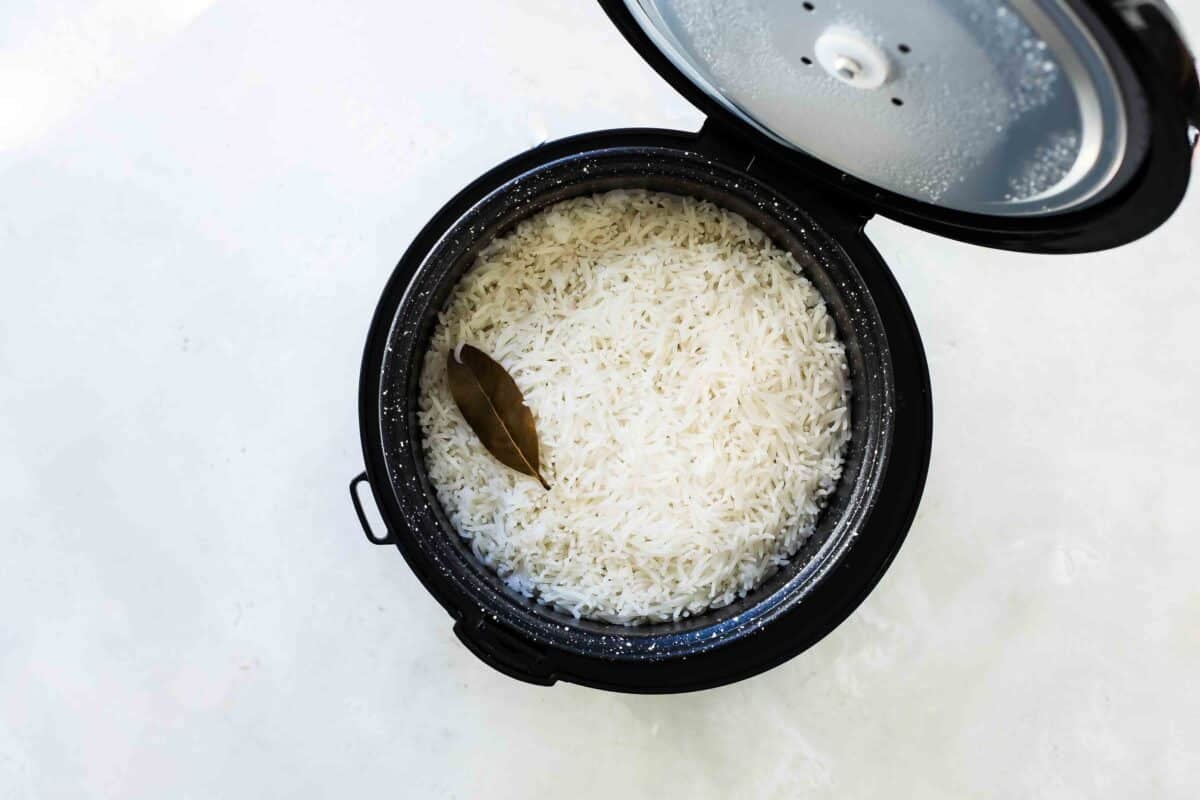
- When the rice is finished, remove bay leaf. Stir in cilantro, lime juice, and lemon juice. Add more salt to taste (I like ¼ teaspoon). Serve hot or at room temperature.
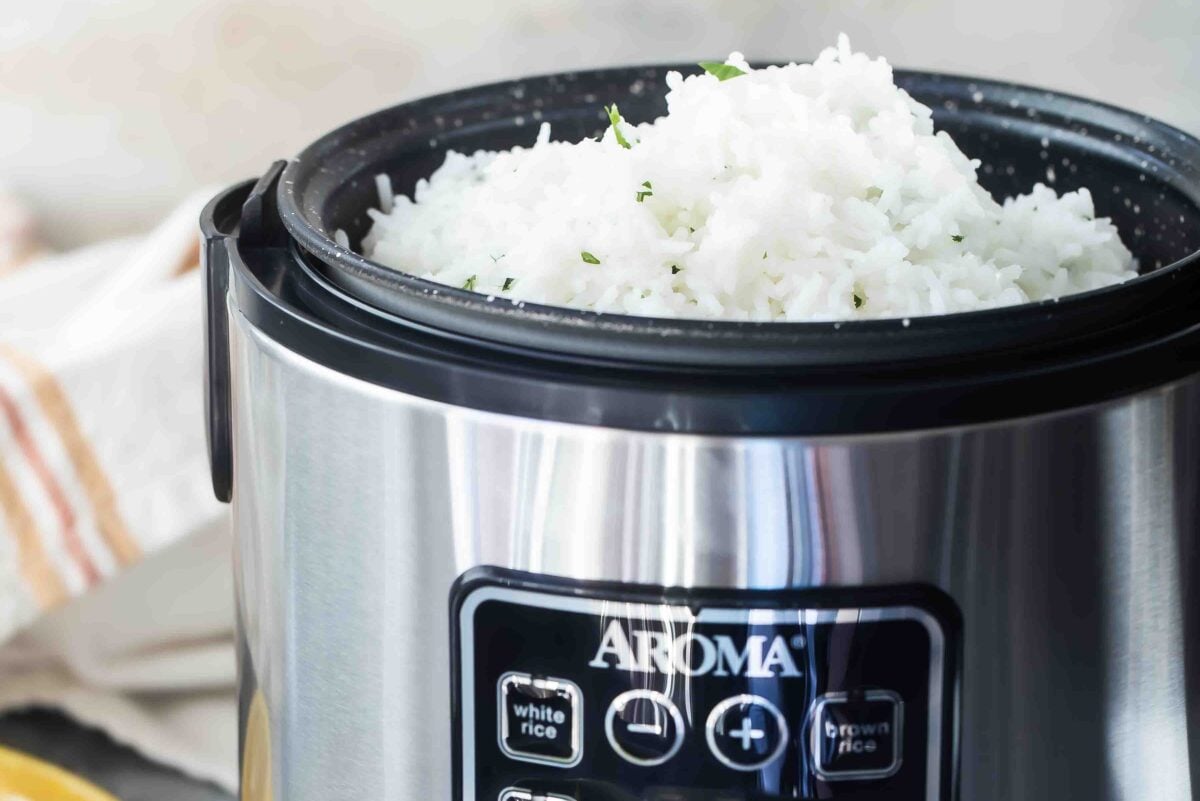
Method 4: Cilantro-Lime Brown Rice
You can cook Cilantro Lime Brown Rice in a rice cooker (easy, because most rice cookers have a ‘brown rice’ button) or on the stove top. I prefer to use brown Basmati rice, but any long-grain brown rice will do.
Because brown rice takes a little longer, just follow the revised cooking times as outlined in Step 7 of the recipe.
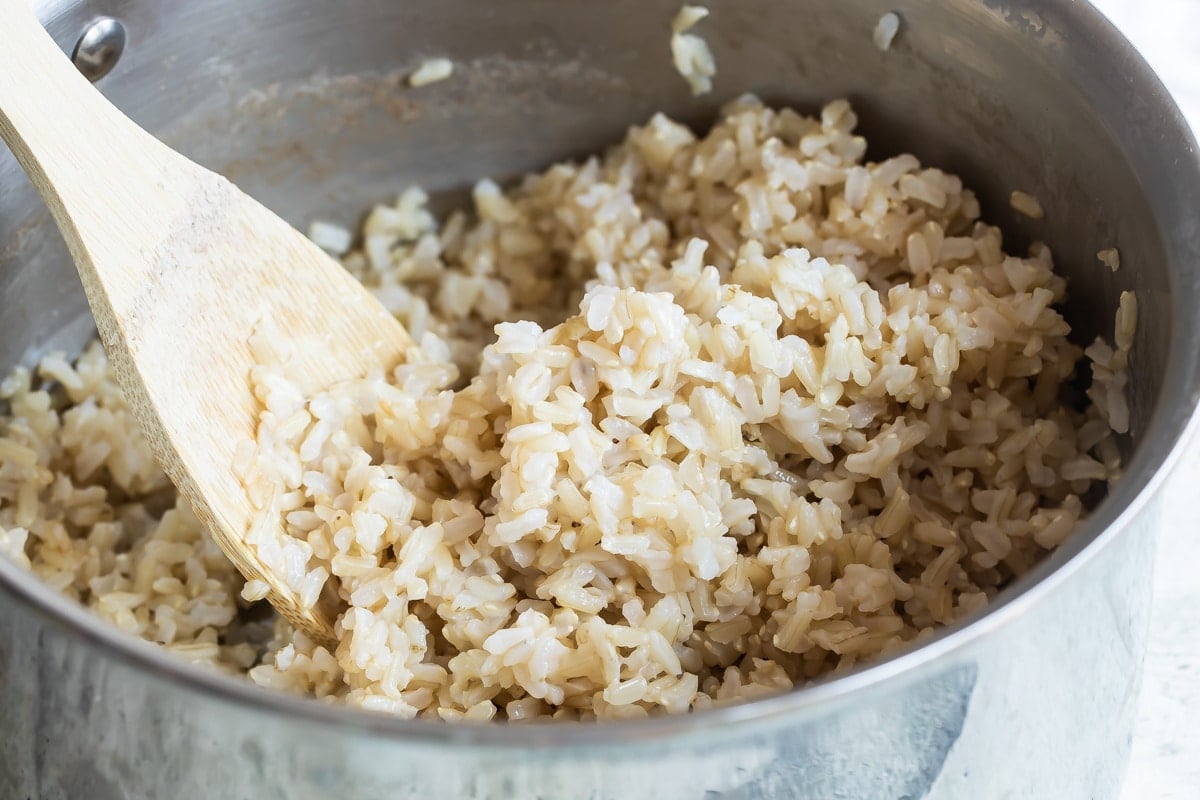
Recipe tips and variations
- Yield: 1 cup uncooked white rice makes 3 cups cooked white rice. 1 cup uncooked brown rice makes 4 cups cooked brown rice. This recipe will make about 6 cups Cilantro-Lime Rice, enough for 12 (½ cup) servings. That means it’s great for plenty of burrito bowls and meal prep!
- Storage: Store leftovers covered in the refrigerator for up to 4 days.
- Freezer: Rice is one of the easiest things to freeze. I love to pack it into 2-cup portions (in plastic bags). Label, date, and lay flat in the freezer. Freeze for up to 3 months. Thaw as needed or add to soups or stir-fries straight from the freezer.
- Cilantro haters: If you happen to be one of the millions of people who despise cilantro (it’s not your fault), you can ask for rice without cilantro at Chipotle.
- Chipotle Burrito Bowls: Make your own copycat burrito bowls, tacos, and salads at home with my full collection of Chipotle Copycat Recipes:
- Proteins: Chipotle Chicken, Chipotle Steak, Chipotle Barbacoa, Chipotle Carnitas, Chipotle Sofritas
- Sides:Chipotle Cilantro-Lime Rice, Chipotle Black Beans, Chipotle Pinto Beans, Chipotle Fajita Veggies
- Sauces: Chipotle Guacamole, Chipotle Tomato Salsa, Chipotle Corn Salsa, Chipote Tomatillo Salsa, Chipotle Hot Salsa, Chipotle-Honey Vinaigrette
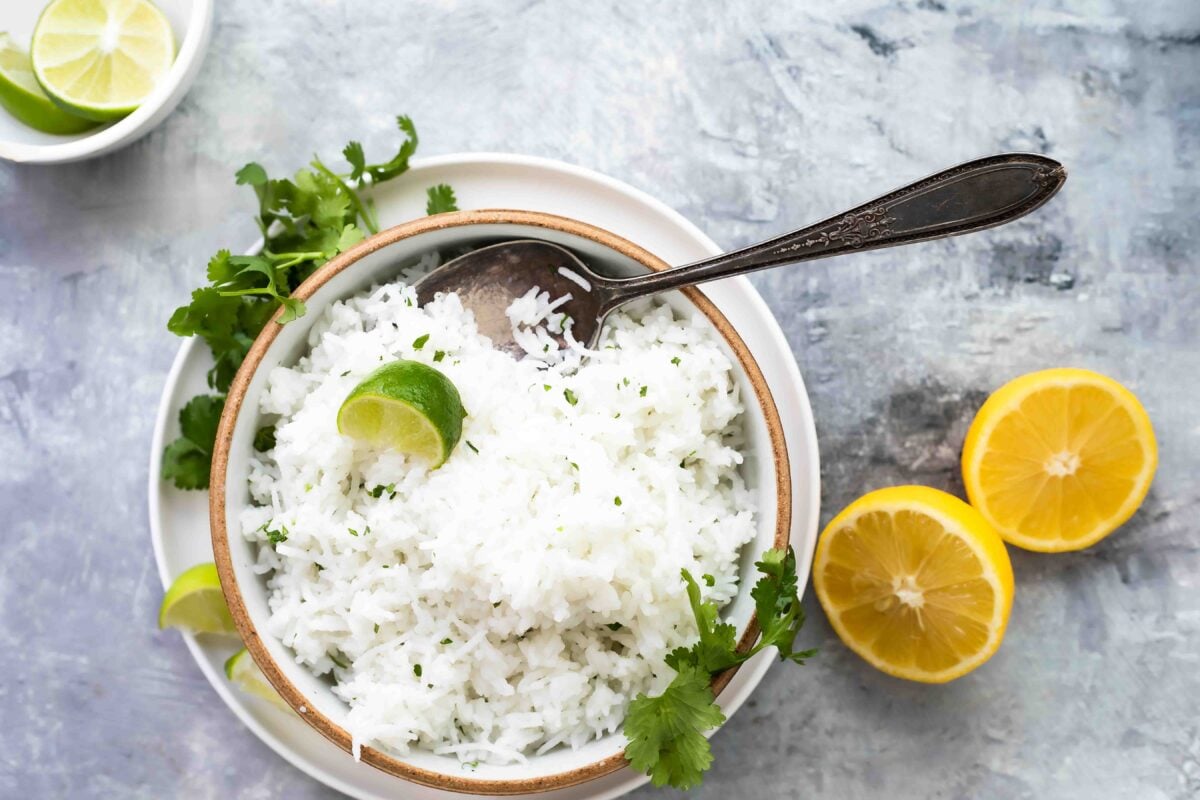
Why I love my rice cooker
I find that rice cookers help make the fluffiest rice and when we rounded up the best rice cookers, our top pick was my personal favorite: The Aroma Housewares Rice Cooker. It’s compact, super simple, and does exactly what it’s supposed to do without fail. My sisters, Erin and Meredith, each have the same one, and we all love it. Not to mention, it has over 6,100 positive reviews. That’s a whole lot of rice!
You can buy my favorite rice cooker for $42 at Target, or you can get the smaller 4-cup version for about $30 on Amazon.
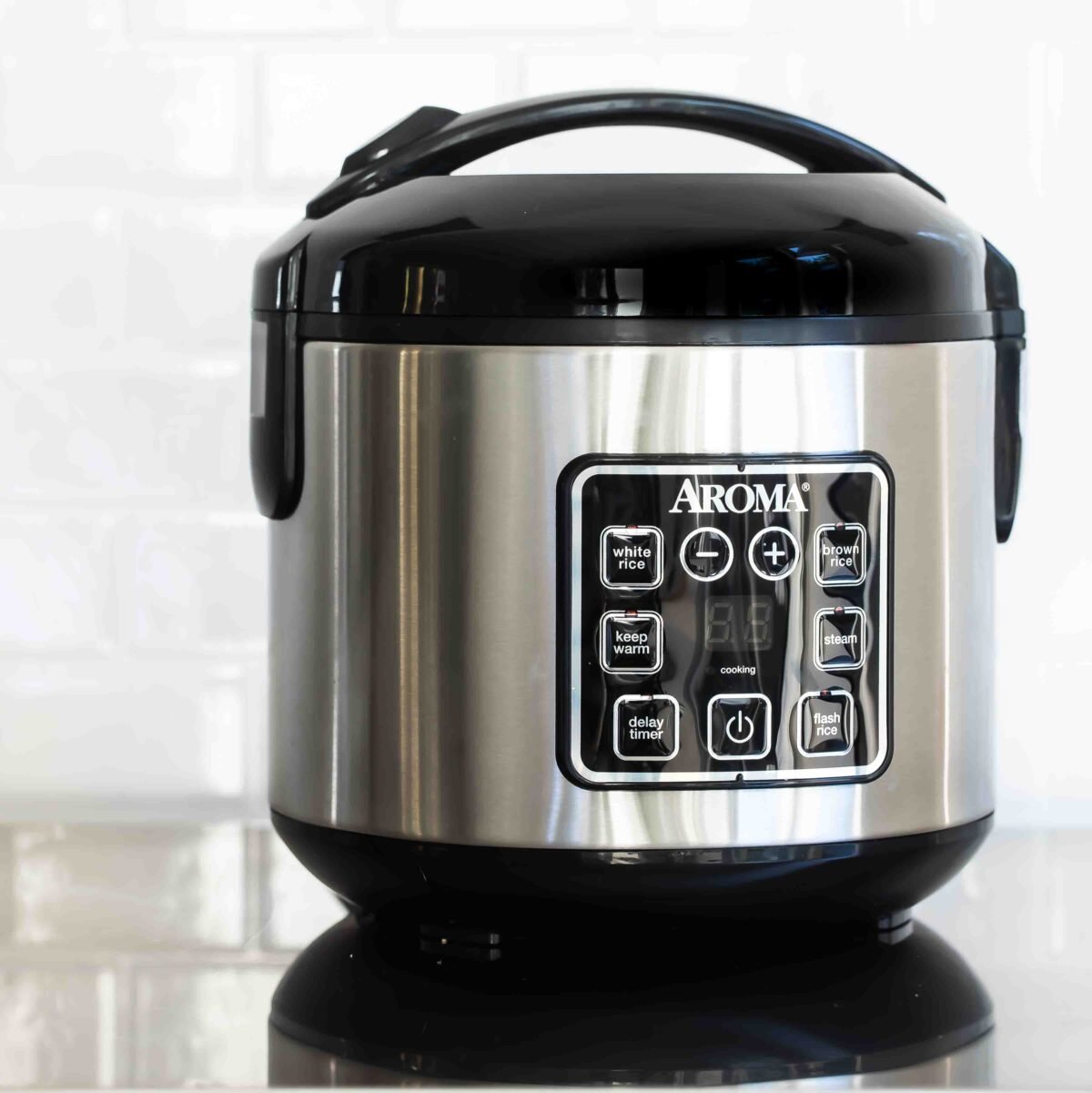
Rice cookers can cook polenta beautifully, also, without stirring it for a million hours. It’s not just a one-job appliance. And if you’re not sold on my rice cooker, others on our list have slow cooker capabilities, too.
Recipe FAQs
1 cup uncooked white rice makes 3 cups cooked white rice. 1 cup uncooked brown rice makes 4 cups cooked brown rice.
Brown rice is considered a whole grain, with fibrous bran, germ, and all. Fiber, vitamins, and minerals are all stored in the bran and germ. White rice has had the bran and germ removed in processing, and so it’s technically less nutritious than brown rice. (But it’s still delicious!)
Brown rice takes quite a bit longer than white rice in terms of cooking, but instructions on how to make Cilantro Lime Brown Rice are in the recipe card below, in case you are interested.
Chipotle Copycat Recipes
Chipotle Chicken (Copycat)
Chipotle Copycat Recipes
Chipotle Steak (Copycat)
Chipotle Copycat Recipes
Chipotle Barbacoa (Copycat)
Chipotle Copycat Recipes
Chipotle Carnitas Copycat
Join Us
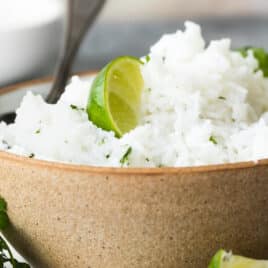
Chipotle Cilantro Lime Rice (Copycat)
Equipment
- Rice Cooker (optional; I own and recommend the Aroma Housewares Rice Cooker)
Ingredients
- 2 cups basmati rice unrinsed, or any long-grain white rice, rinsed (see note 1)
- 1 bay leaf
- Salt
- 1 teaspoon olive oil or rice bran oil, optional
- 2 tablespoons fresh cilantro minced (or omit or sub parsley)
- 2 tablespoons fresh lime juice from 1-2 limes
- 2 tablespoons fresh lemon juice from 1-2 lemons
Instructions
To cook basmati rice on the stove top:
- Bring 8 cups water to a boil in a large pot. Add rice, bay leaf, oil if using, and salt to taste (I like 2 teaspoons). Stir and return to a boil. Boil uncovered for 10 to 12 minutes (for me it's always 12, but some readers have reported mushy rice after 12 minutes, so keep an eye on yours).
- Remove bay leaf. Using a fine mesh strainer, drain rice and rinse with hot water. Pour into a large bowl.
- Stir in cilantro, lime juice, and lemon juice. Season to taste with salt (I like an additional ¼ teaspoon). Serve hot or at room temperature.
To cook any long-grain rice on the stove top:
- Bring 4 cups water to a boil in a large pot. Add rice, bay leaf, oil if using, and salt to taste (I like 2 teaspoons). Stir and return to a boil. Reduce heat to low, cover, and cook for 15 minutes.
- Remove bay leaf. Stir in cilantro, lime juice, and lemon juice. Season to taste with salt (I like an additional ¼ teaspoon). Serve hot or at room temperature.
To cook long-grain rice in a rice-cooker:
- Add rinsed rice (see notes), water (according to manufacturer's instructions, see notes), bay leaf, salt (I like 1 teaspoon), and oil if using. Close rice cooker, plug in, and turn on. Cook according to manufacturer's instructions.
- When the rice is finished, remove bay leaf. Stir in cilantro, lime juice, and lemon juice. Add more salt to taste (I like ¼ teaspoon). Serve hot or at room temperature.
To cook brown rice:
- Follow the instructions above using the following times: 40 minutes for Basmati on the stove top, 45 minutes for long-grain on the stove top, and 60 – 70 minutes for a rice cooker (or according to manufacturer’s instructions). 2 cups brown rice makes 16 servings, ½ cup each (higher yield than white rice).
Recipe Video
Notes
- Long-grain rice (not Basmati): If using a long-grain rice other than Basmati, I recommend rinsing it before cooking it to remove excess starch. To rinse the rice, place it in a fine-mesh sieve under cool water and rinse until the water runs clear. Drain well before adding the rice to the pot or rice cooker. Or, soak the rice in a large bowl of water for up to 30 minutes to help remove starch while conserving water.
- When using a rice cooker, it is important to follow the manufacturer’s instructions for rice and water portions. Many rice cookers come with a specific “measuring cup” that may not be equivalent to a standard 8-ounce cup. They will also specify exactly how much water to use in relation to their measuring cup for best results. Those instructions supersede my quantities of rice and water here, but the other ingredients should remain the same (subject to your own taste preference, of course). If you’re looking to buy a rice cooker, I use and recommend the Aroma Housewares Rice Cooker, which you can buy from Amazon.
- Yield: 1 cup uncooked white rice makes 3 cups cooked white rice. 1 cup uncooked brown rice makes 4 cups cooked brown rice. This recipe will make about 6 cups Cilantro-Lime Rice, enough for 12 (½ cup) servings. That means it’s great for plenty of burrito bowls and meal prep!
- Storage: Store leftovers covered in the refrigerator for up to 4 days.
- Freezer: Rice is one of the easiest things to freeze. I love to pack it into 2-cup portions (in plastic bags). Label, date, and lay flat in the freezer. Freeze for up to 3 months. Thaw as needed or add to soups or stir-fries straight from the freezer.
Nutrition
Meggan Hill is a classically-trained chef and professional writer. Her meticulously-tested recipes and detailed tutorials bring confidence and success to home cooks everywhere. Meggan has been featured on NPR, HuffPost, FoxNews, LA Times, and more.
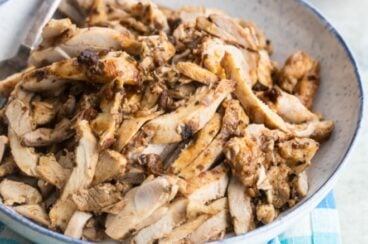
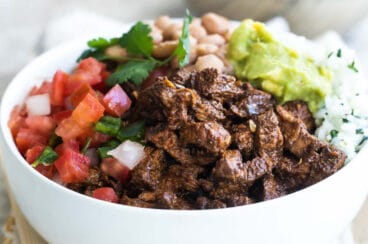
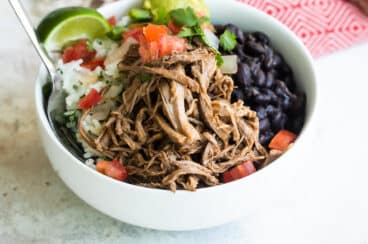
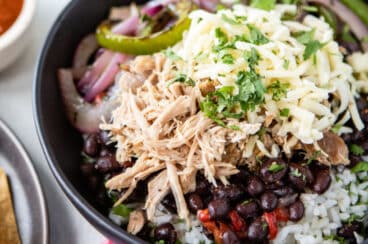
Do you have to use the pasta method if you using basmati rice?
You don’t have to use the pasta method for basmati rice, it is just my favorite way to make this recipe. – Meggan
Thank you, also can this be made a ahead of time and reheated? And what if I do not have bay leaves, what would you suggest as a substitute?
Thanks, Holly
Yes, you can make this up to 3 days in advance. I like to pack it in bags and lay it flat. You can also freeze it that way for a month or two. Frozen rice is one of my favorite things to keep on hand! I typically reheat all rice in the microwave. As for the bay leaf, I wouldn’t necessarily suggest anything else in its place. The bay leaf isn’t necessary except that Chipotle uses it so it gives it that “Chipotle restaurant” kind of flavor. But other than that, it’s entirely unnecessary. You could use any other herb that you like, but personally, I’d just leave out the bay leaf. Thank you! – Meggan
I tried different recipes and to me all I tasted was plain white rice which has a distinct flavor or lack there of.
I really never found one that recommended cooking with the salt added in the cook. Also, I’ve always used Jasmine rice.
Yesterday I used plain white rice, the cheap stuff.
And it really made all the difference I think.
I added the finely chopped cilantro and a few dashes more of salt after the cook and was rather impressed. Was it the same as Chipotle exactly, not really but it was close enough! Then I added the lime and lemon, and while it changed the flavors a bit, it really didnt seem to get any closer to Chipotle’s. And I think the difference was that my rice seemed to be a bit more mushy and starchy. I rinsed my rice for about 5 minutes, THEN I let it sit in a bowl of cool water for about 5 minutes, then I rinsed it again and again, then did the bowl thing ago. Basically I rinsed until the water was clear…which took forever!
So I dont know, I may experiment with a different rice, but I certainly wasn’t disappointed.
THIS IS the closest I’ve gotten to Chipotle rice. Everything this Author posts is legit. I’ve tried everything and it’s at worst an A- if you are looking for restaurant accuracy. Put it all together and it’s an A+!!!
It’s worth mentioning that if you make the bean, meat recipes and then make this rice, you will need to make a couple / few batches of rice to have enough for the beans/meat. So pickup more cilantro while you are at the store if you plan to do copycat Chipotle burrito bowls for the entire family
Hi Scott, wow thank you so much for your enthusiasm! I love your granular detail here. I’m glad the recipe (or your version of it!) turned out well, wasn’t disappointing, and that you’re happy. That’s really all I want – happy readers, successful home cooks. I’m so relieved! Thank you so much. -Meggan
So thrilled to have found this recipe. Have made it according to instructions written for the types of rice in the recipe and it comes out perfect every single time. We start watching it around 11-12 minutes as also indicated in the instructions. Will never need another rice recipe 🥰🥰🥰 Thank you so much!! ❤️❤️❤️
You’re so welcome, Heather! Thank you for trusting my recipe. I’m so glad you all love it! 😊 – Meggan
Hi, I came to your site looking for a cilantro lime rice recipe, but as I was scrolling past the rice-cooking directions, I noticed you didn’t have the long-soak method for brown rice.
I tried for years to get my family to eat brown rice, but they just never cared for the texture and flavor. (Plus it must be stored in the freezer to stave off becoming rancid if not used up very quickly.)
I had been experimenting with soaking and sprouting my beans and other seeds, I’d seen the long-soak method for brown rice mentioned, and thought “why not try it?” I tried a 6 or 7 day soak (cooked stove top method, as I usually would with unsoaked brown rice), and I got a much more enthusiastic reception for my it, especially with regards to flavor from the two pickiest critics. You can find specific information from most sites dedicated to sprouting.
I just thought it was worth mentioning for all the folks who usually forego brown rice for its flavor.
Hi D, thank you so much for sharing your tips! I appreciate it! – Meggan
I don’t see a pinterest link. ?
Hi Amy, sorry about that! Here’s the link to the recipe from Pinterest: https://www.pinterest.com/pin/345580971417349564/. Take care! – Meggan
I made 4 of your Chipotle copycat recipes tonight to make for an amazing Burrito bowl meal…it was so spot on and better than Chipotle according to my kids! The reason their rice may be mushy is because you are telling them to boil 8 cups of water for 2 cups of rice. I followed the directions on my rice, which told me to use 2 cups of water per one cup of rice..I would tell them to follow the directions on their rice adding the bay leaf, salt and oil…it was perfect and amazing!!
I wondered the same thing. 8 cups of water for 2 cups of rice seemed off. I’d always been told 2 cups of water per 1 cup of rice.
Hi Pesh, thanks for your comment. The method I describe and use in this recipe is the pasta method. I’m not the rice police, you can make your rice as you wish! I hope you try this out and please write back and let me know what you think. Take care! – Meggan
Would an Instant Pot work instead of the rice cooker?
Hi Brandy, thank you for your question. I haven’t tried this rice in an Instant Pot, sorry. I would recommend following directions to cook basmati rice in an Instant Pot (with the bay leaves), then stir in cilantro, lime juice, lemon juice, and salt to taste when cooked. Sorry about that again! – Meggan
Excellent. So happy to have found this easy recipe.
I’m happy you found it too, Judy! Take care! – Meggan